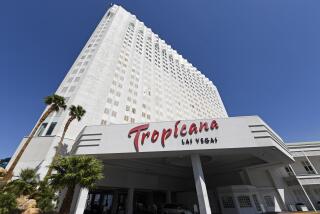Chumash casino expansion to include 12-story hotel tower
The Chumash tribe will begin construction in coming weeks of a $100-million expansion of its Las Vegas-style casino that will bring a 12-story hotel tower and rooftop pool to the hills of the Santa Ynez Valley.
The project by the Santa Ynez Band of Chumash Indians is going forward despite concerns by an array of local and state agencies, including the attorney general’s office and the Santa Barbara County Board of Supervisors, and is sure to sow more bitterness in the ongoing dispute over the bucolic valley’s future.
“It’s very distressing because people see it as a Las Vegas, big-city, urban-style development going right in this rural, agricultural area,” said county Supervisor Doreen Farr, who represents the valley.
The project would add 45,000 square feet to its 94,000-square-foot gaming floor, a five-story garage containing 584 parking spaces and more food and beverage services, primarily with the addition of a food court.
But most significant is the 215-room tower that will triple the size of the hotel; it currently has 106 rooms and 17 luxury suites.
Tribal Chairman Vincent Armenta said the expansion will create 250 much-needed permanent jobs in Santa Barbara County and rejected claims that it would negatively impact water supplies, the environment and law enforcement resources. It is expected to be completed in 2016.
“This is a region that relies heavily on tourism so by adding amenities, we’re helping tourism in the valley,” Armenta said Monday.
Atty. Gen. Kamala D. Harris wrote to Armenta in August, saying the tribe did not adequately consider alternatives to the tower, its visual impact nor the potential effect of increased water use.
But Armenta said the expansion was designed to mesh with the landscape and noted the resort already uses less water than it is allocated because of conservation efforts. He said he doesn’t foresee the expansion putting water supplies in jeopardy.
“We’re using less water now than we were using 10 years ago,” Armenta said.
In addition to the other concerns, Farr said the tribe’s offer to pay for extra fire and sheriff’s services was inadequate.
“We’ve offered on numerous occasions to provide additional fire and law enforcement services for the valley, and the county can accept that or not,” Armenta said. “So far, they have rejected it every time.”
Tensions are already high among some valley residents because the Chumash band is trying to effectively annex land about 2 miles away from its reservation 30 miles northeast of Santa Barbara.
The band bought the 1,400 acres, known as Camp 4, in 2010 from the late actor Fess Parker. It plans to build 143 homes for tribal members and descendants on the property.
The tribe is working through Congress and the federal government to use a land transfer program called “fee to trust” for the property. If successful, the Chumash would assert similar jurisdiction over the land as it does over its existing reservation.
It also would allow the tribe to avoid many development regulations, much as it is doing with the casino expansion.
Farr says the issue shows that counties should have a stronger voice in discussions over development and expansion by tribes with original contracts negotiated when Indian gaming was legalized in California nearly two decades ago. Stricter regulations were put in place for later compacts, she said.
“The hope going forward is that there can be a stronger role for local jurisdictions to require mitigation, which is at the heart of the problem,” she said.
For more Central Coast news, follow @amcovarrubias.
More to Read
Start your day right
Sign up for Essential California for news, features and recommendations from the L.A. Times and beyond in your inbox six days a week.
You may occasionally receive promotional content from the Los Angeles Times.







